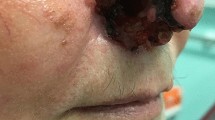Abstract
Objective
Aplasia of lacrimal and salivary glands (ALSG) is a rare autosomal dominant inherited disease, characterized by aplasia, atresia, or hypoplasia of the lacrimal and salivary systems with variable expressivity. The purpose of this study was to identify genetic etiology of an ALSG family.
Materials and methods
We recruited a Turkish family with ALSG and performed a mutational analysis, based on the candidate gene approach, to clarify the molecular genetic etiology.
Results
The candidate gene sequencing of the FGF10 gene identified a novel heterozygous nonsense mutation (c.237G > A, p.Trp79*) in the exon 1.
Conclusion
The identified novel mutation would result in a haploinsufficiency of the FGF10, because of nonsense-mediated mRNA decay caused by a premature stop codon. This report further confirms that ALSG is caused by the haploinsufficiency of functional FGF10.
Clinical relevance
Identification of the genetic etiology of the ALSG will help both the family members and dentist understand the nature of the disorder. Therefore, it will positively motivate oral health care to avoid further destruction of the tooth due to the lack of salivary production.





Similar content being viewed by others
References
Milunsky JM, Lee VW, Siegel BS, Milunsky A (1990) Agenesis or hypoplasia of major salivary and lacrimal glands. Am J Med Genet 37:371–374. doi:10.1002/ajmg.1320370316
Entesarian M, Matsson H, Klar J, Bergendal B, Olson L, Arakaki R et al (2005) Mutations in the gene encoding fibroblast growth factor 10 are associated with aplasia of lacrimal and salivary glands. Nat Genet 37:125–127. doi:10.1038/ng1507
Shiang EL, Holmes LB (1977) The lacrimo-auriculo-dento-digital syndrome. Pediatrics 59:927–930
Rohmann E, Brunner HG, Kayserili H, Uyguner O, Nurnberg G, Lew ED et al (2006) Mutations in different components of FGF signaling in LADD syndrome. Nat Genet 38:414–417. doi:10.1038/ng1757
Entesarian M, Dahlqvist J, Shashi V, Stanley CS, Falahat B, Reardon W et al (2007) FGF10 missense mutations in aplasia of lacrimal and salivary glands (ALSG). Eur J Hum Genet 15:379–382. doi:10.1038/sj.ejhg.5201762
Milunsky JM, Zhao G, Maher TA, Colby R, Everman DB (2006) LADD syndrome is caused by FGF10 mutations. Clin Genet 69:349–354. doi:10.1111/j.1399-0004.2006.00597.x
Itoh N, Ohta H (2014) Fgf10: a paracrine-signaling molecule in development, disease, and regenerative medicine. Curr Mol Med 14:504–509
Itoh N, Ornitz DM (2008) Functional evolutionary history of the mouse Fgf gene family. Dev Dyn 237:18–27. doi:10.1002/dvdy.21388
Beenken A, Mohammadi M (2009) The FGF family: biology, pathophysiology and therapy. Nat Rev Drug Discov 8:235–253. doi:10.1038/nrd2792
Zhang X, Ibrahimi OA, Olsen SK, Umemori H, Mohammadi M, Ornitz DM (2006) Receptor specificity of the fibroblast growth factor family. The complete mammalian FGF family. J Biol Chem 281:15694–15700. doi:10.1074/jbc.M601252200
Qu X, Carbe C, Tao C, Powers A, Lawrence R, van Kuppevelt TH et al (2011) Lacrimal gland development and Fgf10-Fgfr2b signaling are controlled by 2-O- and 6-O-sulfated heparan sulfate. J Biol Chem 286:14435–14444. doi:10.1074/jbc.M111.225003
Lew ED, Bae JH, Rohmann E, Wollnik B, Schlessinger J (2007) Structural basis for reduced FGFR2 activity in LADD syndrome: implications for FGFR autoinhibition and activation. Proc Natl Acad Sci U S A 104:19802–19807. doi:10.1073/pnas.0709905104
Nie X, Luukko K, Kettunen P (2006) FGF signalling in craniofacial development and developmental disorders. Oral Dis 12:102–111. doi:10.1111/j.1601-0825.2005.01176.x
Sekine K, Ohuchi H, Fujiwara M, Yamasaki M, Yoshizawa T, Sato T et al (1999) Fgf10 is essential for limb and lung formation. Nat Genet 21:138–141. doi:10.1038/5096
Min H, Danilenko DM, Scully SA, Bolon B, Ring BD, Tarpley JE et al (1998) Fgf-10 is required for both limb and lung development and exhibits striking functional similarity to Drosophila branchless. Genes Dev 12:3156–3161
Puk O, Esposito I, Soker T, Loster J, Budde B, Nurnberg P et al (2009) A new Fgf10 mutation in the mouse leads to atrophy of the harderian gland and slit-eye phenotype in heterozygotes: a novel model for dry-eye disease? Invest Ophthalmol Vis Sci 50:4311–4318. doi:10.1167/iovs.09-3451
Acknowledgments
We thank the participants in this study for their cooperation.
Author information
Authors and Affiliations
Corresponding author
Ethics declarations
Funding
This work was supported by grants by the National Research Foundation of Korea (NRF) grant funded by the Korean government (2014R1A2A1A11049931).
Conflict of interest
The authors declare that they have no conflict of interest.
Ethical approval
All procedures performed in studies involving human participants were in accordance with the ethical standards of the institutional and/or national research committee and with the 1964 Helsinki declaration and its later amendments or comparable ethical standards.
Informed consent
Informed consent was obtained from all individual participants included in the study. The study protocol was reviewed and approved by the Institutional Review Board at Seoul National University Dental Hospital (CRI05003G) and at the University of Istanbul (IRB00009905).
Rights and permissions
About this article
Cite this article
Seymen, F., Koruyucu, M., Toptanci, I.R. et al. Novel FGF10 mutation in autosomal dominant aplasia of lacrimal and salivary glands. Clin Oral Invest 21, 167–172 (2017). https://doi.org/10.1007/s00784-016-1771-x
Received:
Accepted:
Published:
Issue Date:
DOI: https://doi.org/10.1007/s00784-016-1771-x




